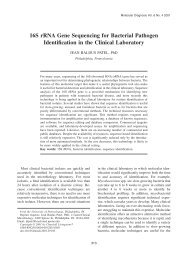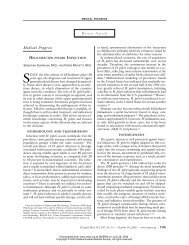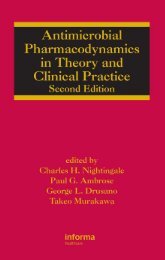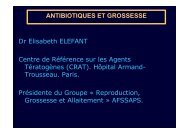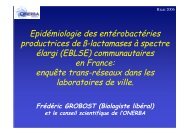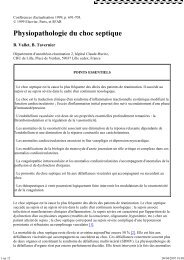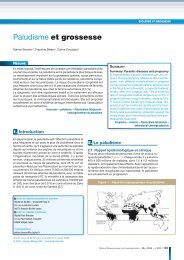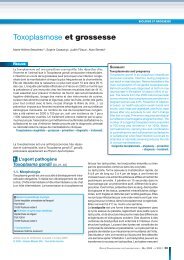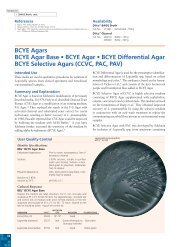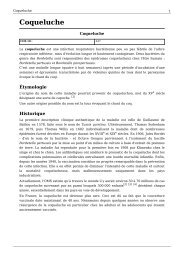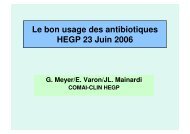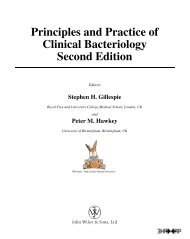Entrez PubMed
Entrez PubMed
Entrez PubMed
You also want an ePaper? Increase the reach of your titles
YUMPU automatically turns print PDFs into web optimized ePapers that Google loves.
<strong>Entrez</strong> <strong>PubMed</strong><br />
http://www.ncbi.nlm.nih.gov/entrez/query.fcgidb=pubmed&cmd=Ret...<br />
1 sur 1 18/05/2007 22:04<br />
My NCBI<br />
[Sign In] [Register]<br />
All Databases <strong>PubMed</strong> Nucleotide Protein Genome Structure OMIM PMC Journals Books<br />
Search <strong>PubMed</strong> for Go Clear<br />
Limits Preview/Index History Clipboard Details<br />
Display AbstractPlus Show 20 Sort by<br />
Send to<br />
All: 1 Review: 0<br />
1: Diagn Microbiol Infect Dis. 2007 Feb 12; [Epub ahead of print]<br />
Links<br />
Inducible clindamycin resistance in Staphylococcus aureus<br />
isolates causing bacteremia at a university hospital in southern<br />
Taiwan.<br />
Janapatla RP, Yan JJ, Huang AH, Chen HM, Wu HM, Wu JJ.<br />
Department of Medical Laboratory Science and Biotechnology, College of<br />
Medicine, National Cheng-Kung University, Tainan 70101, ROC Taiwan.<br />
A major concern while prescribing clindamycin to treat infections<br />
caused by inducible macrolide, lincosamide, and group B<br />
streptogramin (iMLS(B))-resistant strains is clinical therapy<br />
failure. In this study, we determined the prevalence,<br />
mechanism, and clonality of the iMLS(B) phenotype in<br />
oxacillin-resistant Staphylococcus aureus (ORSA) and<br />
oxacillin-susceptible S. aureus (OSSA). Among the 729 OSSA<br />
isolates collected from July 1995 to March 2006, 72 (10%) were<br />
clindamycin sensitive (Cli(s)) and erythromycin resistant<br />
(Erm(r)), and 55 (8%) had the iMLS(B) phenotype. In the 709<br />
ORSA isolates collected from January 1997 to March 2006, 31<br />
(4%) were Cli(s) and Erm(r), and 29 (4%) isolates<br />
demonstrated the iMLS(B) phenotype. In OSSA, ermC was the<br />
predominant (51 of 55 isolates) genetic determinant responsible<br />
for the iMLS(B) phenotype, whereas in ORSA, ermA was<br />
predominant (27 of 29). Pulsed-field gel electrophoresis showed<br />
that 8 pulsed types (RA to RH) were present in ORSA isolates (n<br />
= 27), and pulsed type RC was predominant in 17 isolates with 5<br />
identifiable subtypes (RC1 to RC5); this type was prevalent from<br />
November 1997 to June 2004. In the OSSA (n = 24) isolates, 14<br />
different pulsed types (SA to SN) were identified, but none was<br />
predominant. These results indicate that the incidence of<br />
iMLS(B) resistance phenotype is higher in OSSA than ORSA in<br />
Taiwan, and the genetic determinants responsible for the<br />
iMLS(B) phenotype vary in OSSA and ORSA.<br />
Related Links<br />
Phenotypes and genotypes of<br />
erythromycin-resistant Streptococcus<br />
[Antimicrob Agents Chemother. 1999]<br />
Testing for induction of clindamycin<br />
resistance in erythromycin-resistant<br />
[J Clin Microbiol. 2005]<br />
Prevalence of polyclonal<br />
mefA-containing isolates [J Clin Microbiol. among 2000]<br />
Failure of clindamycin treatment of<br />
methicillin-resistant [Clin Staphylococcus<br />
Infect Dis. 2003]<br />
Practical disk diffusion method for<br />
detection of inducible [J Clin clindamycin<br />
Microbiol. 2003]<br />
See all Related Articles...<br />
PMID: 17300897 [<strong>PubMed</strong> - as supplied by publisher]<br />
Display AbstractPlus Show 20 Sort by<br />
Send to<br />
Write to the Help Desk<br />
NCBI | NLM | NIH<br />
Department of Health & Human Services<br />
Privacy Statement | Freedom of Information Act | Disclaimer<br />
Apr 30 2007 04:56:27
This document was created with Win2PDF available at http://www.win2pdf.com.<br />
The unregistered version of Win2PDF is for evaluation or non-commercial use only.<br />
This page will not be added after purchasing Win2PDF.




